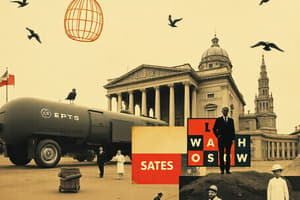Podcast
Questions and Answers
What does the Law of Demand state?
What does the Law of Demand state?
- Quantity supplied remains constant with price changes.
- As price increases, quantity demanded increases.
- As income rises, demand for luxury goods decreases.
- As price decreases, quantity demanded increases. (correct)
Which of the following shifts the demand curve to the right?
Which of the following shifts the demand curve to the right?
- An increase in the price of a substitute good.
- A decrease in population.
- A decrease in consumer income for normal goods.
- A rise in expected future prices. (correct)
What results from a price ceiling set below the market equilibrium?
What results from a price ceiling set below the market equilibrium?
- Increase in supplier profits.
- A surplus of goods in the market.
- A shortage of goods in the market. (correct)
- Increased consumer surplus.
What is a complementary good?
What is a complementary good?
Which factor does NOT typically shift the supply curve?
Which factor does NOT typically shift the supply curve?
What is consumer surplus?
What is consumer surplus?
How does a subsidy generally affect supply?
How does a subsidy generally affect supply?
In the context of market equilibrium, what does a surplus indicate?
In the context of market equilibrium, what does a surplus indicate?
What is meant by the term 'Ceteris Paribus'?
What is meant by the term 'Ceteris Paribus'?
What is a primary consequence of imposing tariffs on imports?
What is a primary consequence of imposing tariffs on imports?
If the marginal cost of producing an additional unit of a product is $10 and the marginal benefit is $8, what should a firm do?
If the marginal cost of producing an additional unit of a product is $10 and the marginal benefit is $8, what should a firm do?
Which of the following is an example of an implicit cost?
Which of the following is an example of an implicit cost?
What does the law of diminishing marginal utility imply?
What does the law of diminishing marginal utility imply?
Which economic system relies primarily on customs and traditions to guide economic decisions?
Which economic system relies primarily on customs and traditions to guide economic decisions?
What is the primary factor limiting production in a production possibilities frontier?
What is the primary factor limiting production in a production possibilities frontier?
Which of the following statements best describes the concept of comparative advantage?
Which of the following statements best describes the concept of comparative advantage?
What is a major benefit of specialization and trade?
What is a major benefit of specialization and trade?
Which type of cost should be ignored when making future economic decisions?
Which type of cost should be ignored when making future economic decisions?
Flashcards
Scarcity
Scarcity
The basic economic problem where unlimited wants exceed limited resources.
Opportunity Cost
Opportunity Cost
The value of the next best alternative forgone when making a choice.
Marginal Costs
Marginal Costs
The additional cost of producing or consuming one more unit of a good.
Economic Decision Rule
Economic Decision Rule
Signup and view all the flashcards
Market Economy
Market Economy
Signup and view all the flashcards
Production Possibilities Frontier (PPF)
Production Possibilities Frontier (PPF)
Signup and view all the flashcards
Comparative Advantage
Comparative Advantage
Signup and view all the flashcards
Law of Diminishing Marginal Utility
Law of Diminishing Marginal Utility
Signup and view all the flashcards
Trade Ratios
Trade Ratios
Signup and view all the flashcards
Law of Demand
Law of Demand
Signup and view all the flashcards
Ceteris Paribus
Ceteris Paribus
Signup and view all the flashcards
Substitution Effect
Substitution Effect
Signup and view all the flashcards
Determinants of Demand
Determinants of Demand
Signup and view all the flashcards
Law of Supply
Law of Supply
Signup and view all the flashcards
Market Equilibrium
Market Equilibrium
Signup and view all the flashcards
Consumer Surplus
Consumer Surplus
Signup and view all the flashcards
Price Ceiling
Price Ceiling
Signup and view all the flashcards
Tariffs
Tariffs
Signup and view all the flashcards
Study Notes
Fundamental Economic Concepts
- Scarcity: Unlimited wants clash with limited resources, a fundamental economic problem.
- Opportunity Cost: The value of the next best alternative forfeited when choosing one option.
- Implicit Costs: Costs not requiring direct payment (like forgone wages).
- Marginal Costs: The additional cost of producing/consuming one more unit.
- Marginal Benefits: The added benefit from producing/consuming one more unit.
- Economic Decision Rule: If marginal benefit exceeds marginal cost, undertake the action; otherwise, don't.
- Sunk Costs: Costs already incurred and unrecoverable; irrelevant to future decisions.
Economic Systems
- Market Economy: Decisions based on supply and demand (e.g., U.S.).
- Command Economy: A central authority (government) controls all economic decisions (e.g., North Korea).
- Traditional Economy: Decisions adhere to customs and traditions (e.g., some indigenous communities).
Choice in a World of Scarcity
- Budget Constraints: Limited income sets spending limits.
- Opportunity Costs: Trade-offs from choosing one option over another.
- Marginal Analysis: Analyzing small, incremental changes for economic decisions.
- Utility: Satisfaction derived from consuming goods/services.
- Law of Diminishing Marginal Utility: Each extra unit consumed yields less additional satisfaction.
- PPF (Production Possibilities Frontier): A graph showing maximum output combinations.
- Law of Diminishing Returns: Adding more of one input, while holding others constant, yields smaller output increases.
- Productive Efficiency: Producing goods at lowest possible cost.
- Allocative Efficiency: Producing goods most desired by society.
- Absolute Advantage: Producing more of a good with the same resources compared to others.
- Comparative Advantage: Producing a good at a lower opportunity cost than others.
- Specialization: Concentrating resources on goods with comparative advantage.
- Gains from Trade: Increased total output from specialization and trade.
- Mutually Beneficial Trade: Trade benefits both parties.
- Trade Ratios (Terms of Trade): Exchange rate of goods between countries (e.g., 1 car for 2 tons of steel).
Supply and Demand
- Demand Schedule (Demand Curve): Table/graph showing quantity demanded at various prices.
- Price vs. Quantity Demanded: Price changes along the demand curve, other factors shift it.
- Ceteris Paribus: "All other things being equal" assumption in economics.
- Law of Demand: Inverse relationship—price decreases, quantity demanded increases.
- Law of Diminishing Marginal Utility: Successive units of a good hold less additional satisfaction.
- Substitution Effect: Consumers switch to cheaper alternatives when prices rise.
- Income Effect: Lower prices raise purchasing power, allowing more consumption.
- Determinants of Demand: Factors that shift the demand curve.
- Income: Normal goods (demand rises with income), inferior goods (demand falls with income).
- Price of Related Goods: Complements (used together) and substitutes (alternatives).
- Preferences: Changes in consumer taste and preferences.
- Expected Future Prices: Anticipated price increases boost current demand.
- Population: More consumers mean higher demand.
- Supply Schedule (Supply Curve): Table/graph showing quantity supplied at various prices.
- Price vs. Quantity Supplied: Price changes along the supply curve, other factors shift it.
- Law of Supply: Direct relationship—price increases, quantity supplied increases.
- Determinants of Supply: Factors that shift the supply curve.
- Factors of Production: Input costs affect supply.
- Number of Suppliers: More suppliers mean higher supply.
- Expected Future Prices: Anticipated price increases reduce current supply.
- Price of Related Goods: Complements and substitutes in production.
- Market Equilibrium: Intersection of supply and demand curves, where quantity demanded = quantity supplied.
- Surplus: Quantity supplied exceeds quantity demanded; leads to price decreases.
- Shortage: Quantity demanded exceeds quantity supplied; leads to price increases.
- Inefficiency from Government Intervention: Price ceilings (below equilibrium) create shortages, price floors (above equilibrium) create surpluses.
- Surplus Measures & Trade: Consumer surplus, producer surplus, gains from trade (social surplus), deadweight loss.
- Government Surplus: Revenue from taxes/subsidies.
- Taxes & Subsidies: Taxes reduce supply and demand, subsidies increase them.
- World Trade: Exchange of goods/services across international markets.
- World Trade with Tariffs/Quotas: Tariffs (taxes on imports) and quotas (limits on imports) protect domestic industries.
Studying That Suits You
Use AI to generate personalized quizzes and flashcards to suit your learning preferences.




